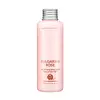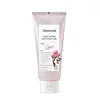What's inside
What's inside
 Key Ingredients
Key Ingredients

 Benefits
Benefits

 Concerns
Concerns

 Ingredients Side-by-side
Ingredients Side-by-side

Dipropylene Glycol
HumectantEthylhexyl Palmitate
EmollientButylene Glycol
HumectantHydrogenated Polydecene
EmollientCetyl Ethylhexanoate
EmollientCyclopentasiloxane
EmollientGlyceryl Stearate
EmollientPEG-100 Stearate
Butyrospermum Parkii Butter
Skin ConditioningDimethiconol
EmollientWater
Skin ConditioningRosa Damascena Flower Water
MaskingPhenoxyethanol
PreservativeHelianthus Annuus Seed Oil
EmollientRosa Hybrid Flower Extract
Skin ConditioningLilium Tigrinum Extract
Skin ConditioningIpomoea Purpurea Extract
Skin ConditioningCentaurea Cyanus Flower Extract
AstringentBorago Officinalis Extract
EmollientViola Mandshurica Flower Extract
AntioxidantSyringa Vulgaris Extract
Skin ConditioningCamellia Japonica Flower Extract
EmollientChrysanthemum Sinense Flower Extract
CleansingHelianthus Annuus Flower Extract
Skin ConditioningNarcissus Pseudo-Narcissus Flower Extract
Skin ConditioningPrunus Serrulata Flower Extract
Skin ConditioningPrunus Armeniaca Fruit Extract
Skin ConditioningNelumbo Nucifera Flower Extract
Skin Conditioning1,2-Hexanediol
Skin ConditioningGlycerin
HumectantAloe Barbadensis Leaf Extract
EmollientSodium Lactate
BufferingSodium Gluconate
Skin ConditioningPolysorbate 60
EmulsifyingSodium Hyaluronate
HumectantCetearyl Alcohol
EmollientSorbitan Sesquioleate
EmulsifyingStearic Acid
CleansingAcrylates/C10-30 Alkyl Acrylate Crosspolymer
Emulsion StabilisingParfum
MaskingPotassium Hydroxide
BufferingXanthan Gum
EmulsifyingDisodium EDTA
BHT
AntioxidantDipropylene Glycol, Ethylhexyl Palmitate, Butylene Glycol, Hydrogenated Polydecene, Cetyl Ethylhexanoate, Cyclopentasiloxane, Glyceryl Stearate, PEG-100 Stearate, Butyrospermum Parkii Butter, Dimethiconol, Water, Rosa Damascena Flower Water, Phenoxyethanol, Helianthus Annuus Seed Oil, Rosa Hybrid Flower Extract, Lilium Tigrinum Extract, Ipomoea Purpurea Extract, Centaurea Cyanus Flower Extract, Borago Officinalis Extract, Viola Mandshurica Flower Extract, Syringa Vulgaris Extract, Camellia Japonica Flower Extract, Chrysanthemum Sinense Flower Extract, Helianthus Annuus Flower Extract, Narcissus Pseudo-Narcissus Flower Extract, Prunus Serrulata Flower Extract, Prunus Armeniaca Fruit Extract, Nelumbo Nucifera Flower Extract, 1,2-Hexanediol, Glycerin, Aloe Barbadensis Leaf Extract, Sodium Lactate, Sodium Gluconate, Polysorbate 60, Sodium Hyaluronate, Cetearyl Alcohol, Sorbitan Sesquioleate, Stearic Acid, Acrylates/C10-30 Alkyl Acrylate Crosspolymer, Parfum, Potassium Hydroxide, Xanthan Gum, Disodium EDTA, BHT
Water
Skin ConditioningRose Extract
Skin ConditioningAlcohol Denat.
AntimicrobialButylene Glycol
HumectantGlycerin
HumectantScutellaria Baicalensis Extract
AntimicrobialSodium Hyaluronate
HumectantNelumbo Nucifera Germ
HumectantPrunus Mume Fruit Extract
HumectantAcrylates/C10-30 Alkyl Acrylate Crosspolymer
Emulsion StabilisingAmmonium Acryloyldimethyltaurate/Vp Copolymer
Ethylhexylglycerin
Skin ConditioningTromethamine
BufferingPEG-60 Hydrogenated Castor Oil
EmulsifyingHydroxyethyl Acrylate/Sodium Acryloyldimethyl Taurate Copolymer
Emulsion StabilisingDimethicone
EmollientDisodium EDTA
Phenoxyethanol
PreservativeParfum
MaskingWater, Rose Extract, Alcohol Denat., Butylene Glycol, Glycerin, Scutellaria Baicalensis Extract, Sodium Hyaluronate, Nelumbo Nucifera Germ, Prunus Mume Fruit Extract, Acrylates/C10-30 Alkyl Acrylate Crosspolymer, Ammonium Acryloyldimethyltaurate/Vp Copolymer, Ethylhexylglycerin, Tromethamine, PEG-60 Hydrogenated Castor Oil, Hydroxyethyl Acrylate/Sodium Acryloyldimethyl Taurate Copolymer, Dimethicone, Disodium EDTA, Phenoxyethanol, Parfum
Ingredients Explained
These ingredients are found in both products.
Ingredients higher up in an ingredient list are typically present in a larger amount.
Acrylates/C10-30 Alkyl Acrylate Crosspolymer is a synthetic polymer. It is used to thicken and improve the texture of products. Due to its properties, it can prevent water and oil ingredients from separating.
Butylene Glycol (or BG) is used within cosmetic products for a few different reasons:
Overall, Butylene Glycol is a safe and well-rounded ingredient that works well with other ingredients.
Though this ingredient works well with most skin types, some people with sensitive skin may experience a reaction such as allergic rashes, closed comedones, or itchiness.
Learn more about Butylene GlycolDisodium EDTA plays a role in making products more stable by aiding other preservatives.
It is a chelating agent, meaning it neutralizes metal ions that may be found in a product.
Disodium EDTA is a salt of edetic acid and is found to be safe in cosmetic ingredients.
Learn more about Disodium EDTAGlycerin is already naturally found in your skin. It helps moisturize and protect your skin.
A study from 2016 found glycerin to be more effective as a humectant than AHAs and hyaluronic acid.
As a humectant, it helps the skin stay hydrated by pulling moisture to your skin. The low molecular weight of glycerin allows it to pull moisture into the deeper layers of your skin.
Hydrated skin improves your skin barrier; Your skin barrier helps protect against irritants and bacteria.
Glycerin has also been found to have antimicrobial and antiviral properties. Due to these properties, glycerin is often used in wound and burn treatments.
In cosmetics, glycerin is usually derived from plants such as soybean or palm. However, it can also be sourced from animals, such as tallow or animal fat.
This ingredient is organic, colorless, odorless, and non-toxic.
Glycerin is the name for this ingredient in American English. British English uses Glycerol/Glycerine.
Learn more about GlycerinParfum is a catch-all term for an ingredient or more that is used to give a scent to products.
Also called "fragrance", this ingredient can be a blend of hundreds of chemicals or plant oils. This means every product with "fragrance" or "parfum" in the ingredients list is a different mixture.
For instance, Habanolide is a proprietary trade name for a specific aroma chemical. When used as a fragrance ingredient in cosmetics, most aroma chemicals fall under the broad labeling category of “FRAGRANCE” or “PARFUM” according to EU and US regulations.
The term 'parfum' or 'fragrance' is not regulated in many countries. In many cases, it is up to the brand to define this term.
For instance, many brands choose to label themselves as "fragrance-free" because they are not using synthetic fragrances. However, their products may still contain ingredients such as essential oils that are considered a fragrance by INCI standards.
One example is Calendula flower extract. Calendula is an essential oil that still imparts a scent or 'fragrance'.
Depending on the blend, the ingredients in the mixture can cause allergies and sensitivities on the skin. Some ingredients that are known EU allergens include linalool and citronellol.
Parfum can also be used to mask or cover an unpleasant scent.
The bottom line is: not all fragrances/parfum/ingredients are created equally. If you are worried about fragrances, we recommend taking a closer look at an ingredient. And of course, we always recommend speaking with a professional.
Learn more about ParfumPhenoxyethanol is a preservative that has germicide, antimicrobial, and aromatic properties. Studies show that phenoxyethanol can prevent microbial growth. By itself, it has a scent that is similar to that of a rose.
It's often used in formulations along with Caprylyl Glycol to preserve the shelf life of products.
Sodium Hyaluronate is hyaluronic acid's salt form. It is commonly derived from the sodium salt of hyaluronic acid.
Like hyaluronic acid, it is great at holding water and acts as a humectant. This makes it a great skin hydrating ingredient.
Sodium Hyaluronate is naturally occurring in our bodies and is mostly found in eye fluid and joints.
These are some other common types of Hyaluronic Acid:
Learn more about Sodium HyaluronateWater. It's the most common cosmetic ingredient of all. You'll usually see it at the top of ingredient lists, meaning that it makes up the largest part of the product.
So why is it so popular? Water most often acts as a solvent - this means that it helps dissolve other ingredients into the formulation.
You'll also recognize water as that liquid we all need to stay alive. If you see this, drink a glass of water. Stay hydrated!
Learn more about Water